Charles E W Bean, Diaries, AWM38 3DRL 606/270 PART 3/1 - 1918 - 1939 - Part 6
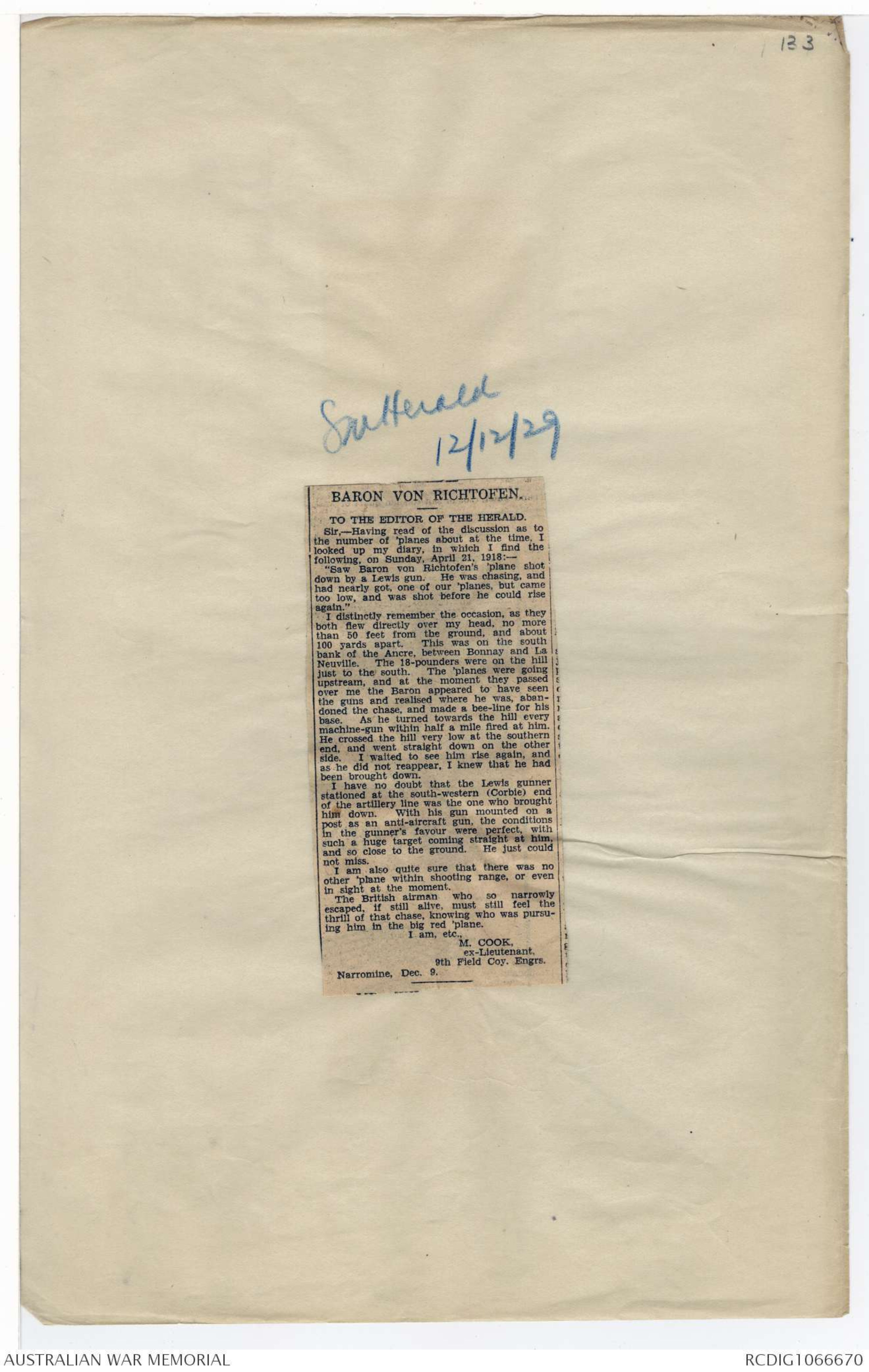
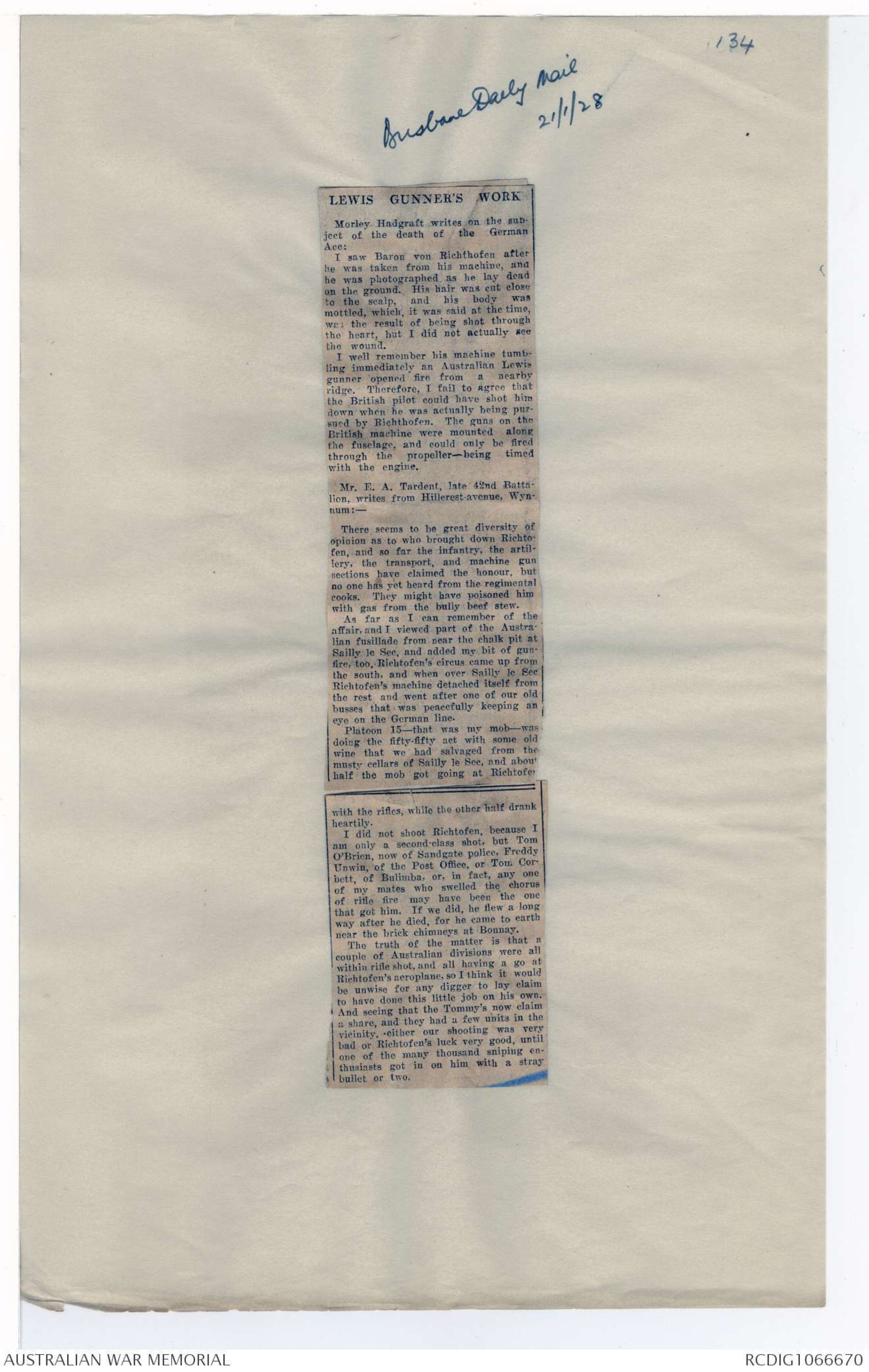
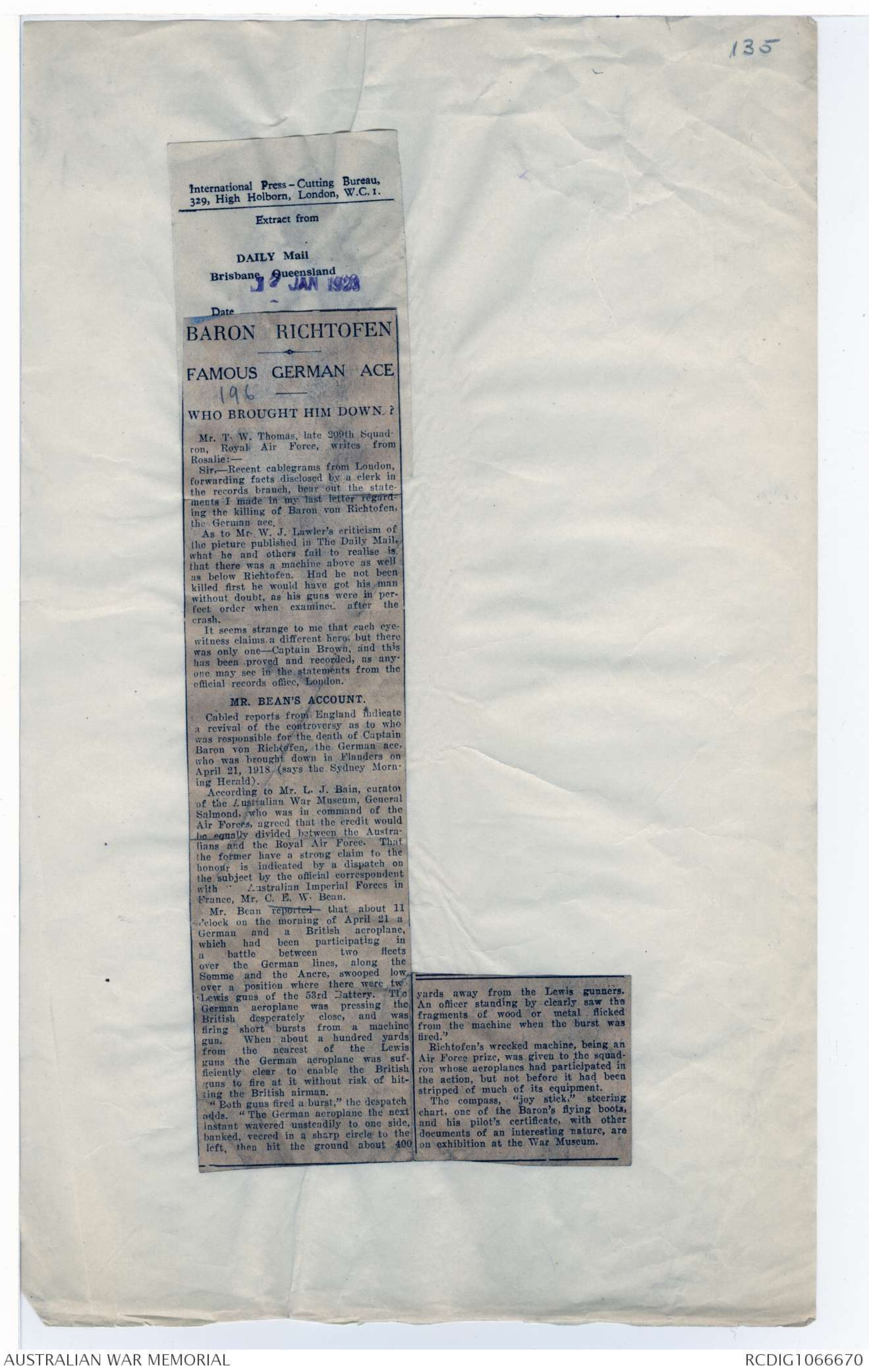

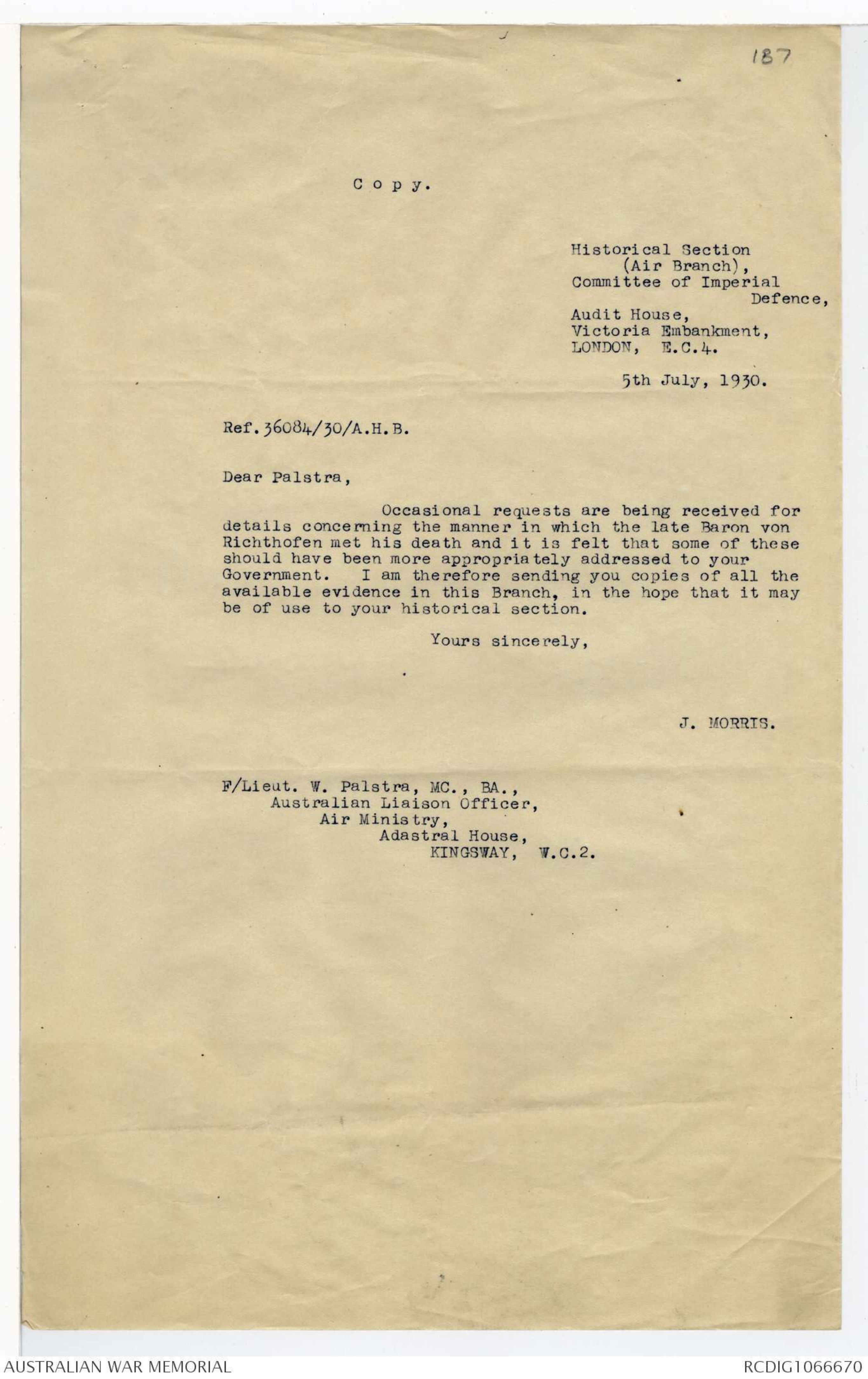
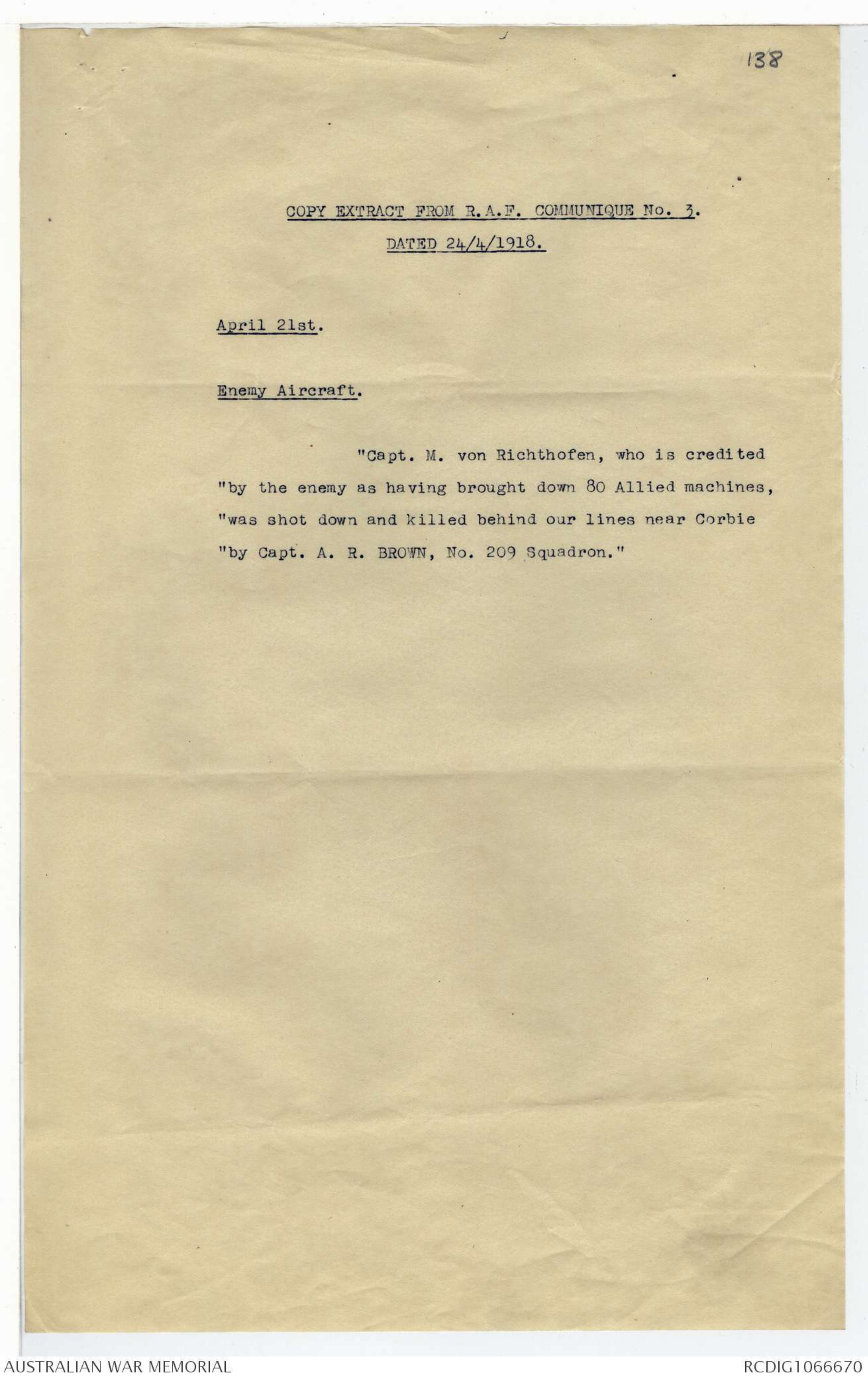
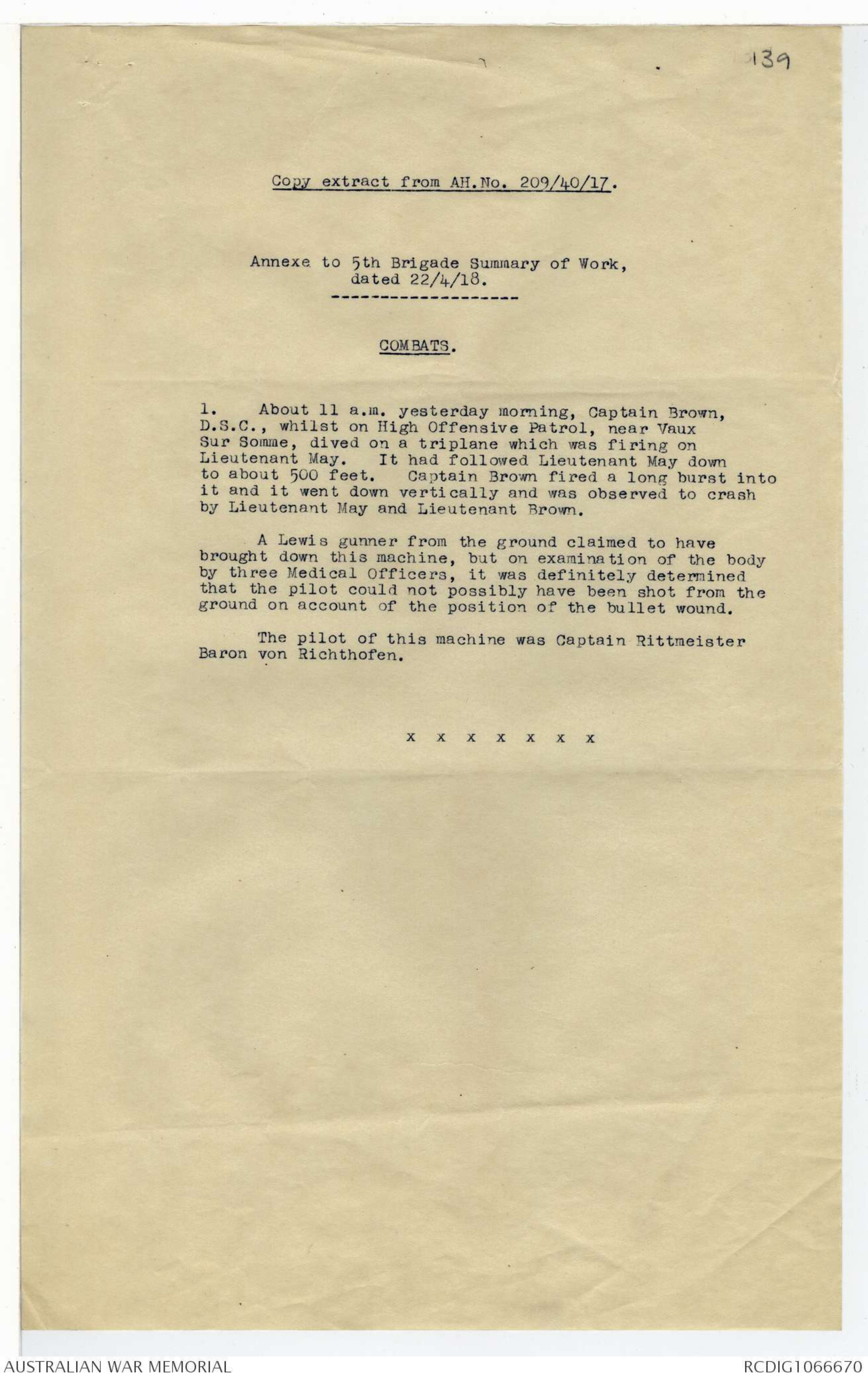
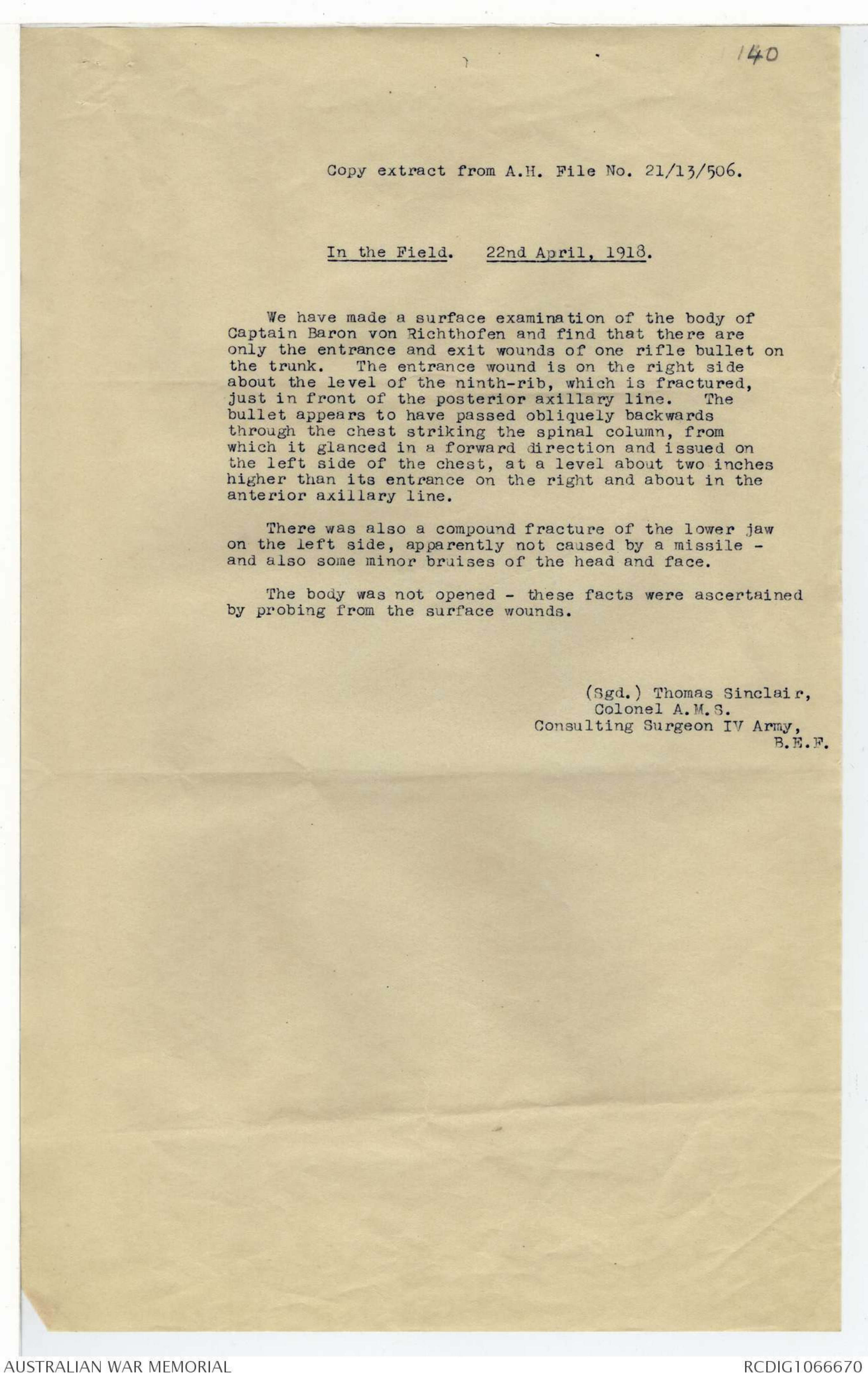
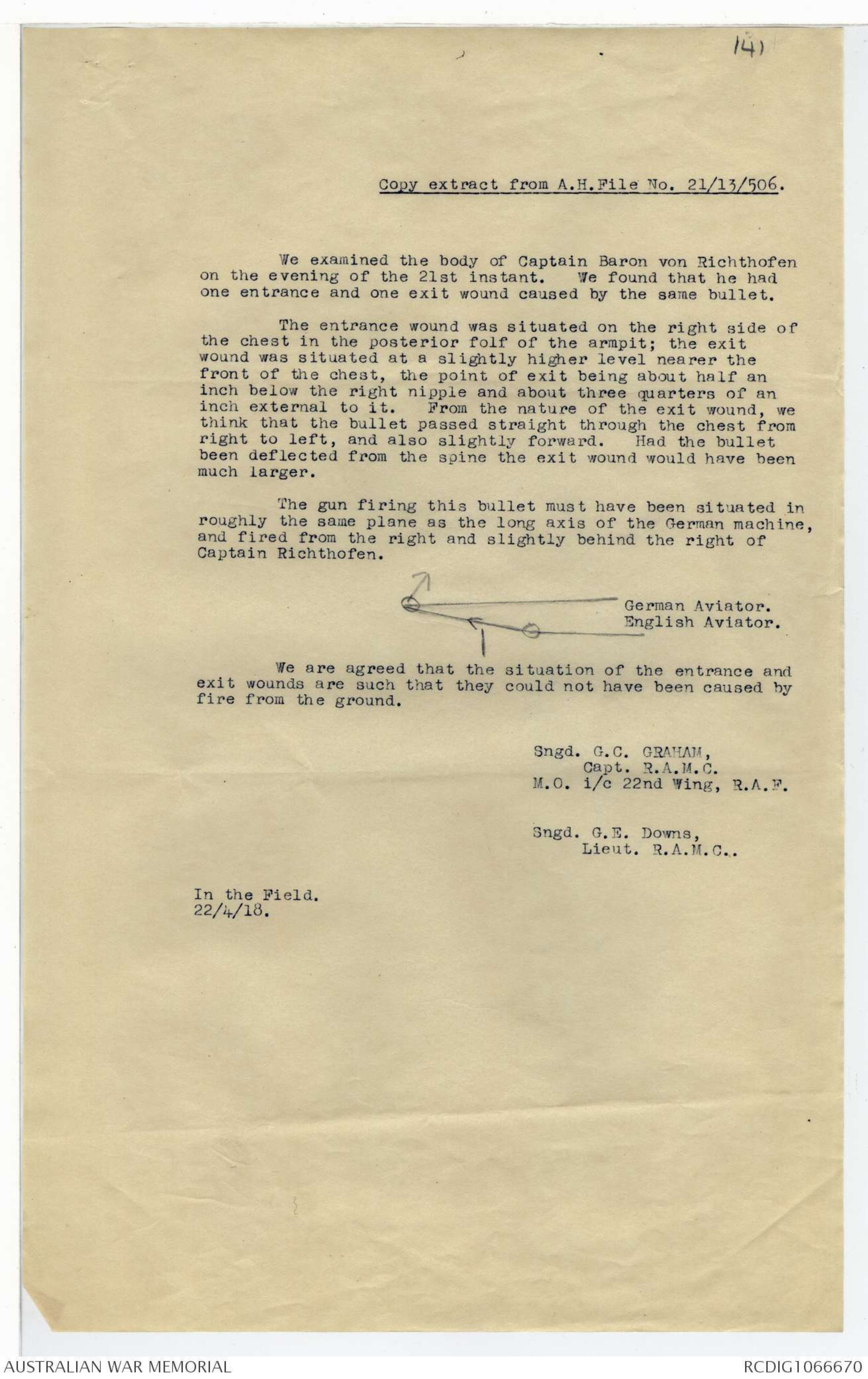

133
[*SM Herald
12/12/29*]
BARON VON RICHTOFEN.
TO THE EDITOR OF THE HERALD.
Sir.-Having read of the discussion as to
the number of 'planes about at the time, I
looked up my diary, in which I find the
following, on Sunday, April 21. 1918:-
"Saw Baron von Richtofen's 'plane shot
down by a Lewis gun. He was chasing, and
had nearly got, one of our 'planes, but came
too low, and was shot before he could rise
again".
I distinctly remember the occasion, as they
both flew directly over my head, no more
than 50 feet from the ground, and about
100 yards apart. This was on the south
bank of the Ancre, between Bonnay and La
Neuville. The 18-pounders were on the hill
just to the south. The 'planes were going
upstream, and at the moment they passed
over me the Baron appeared to have seen
the guns and realised where he was, abandoned
the chase, and made a bee-line for his
base. As he turned towards the hill every
machine-gun within half a mile fired at him.
He crossed the hill very low at the southern
end, and went straight down on the other
side. I waited to see him rise again, and
as he did not reappear, I knew that he had
been brought down.
I have no doubt that the Lewis gunner
stationed at the south-western (Corbie) end
of the artillery line was the one who brought
him down. With his gun mounted on a
post as an anti-aircraft gun, the conditions
in the gunner's favour were perfect, with
such a huge target coming straight at him,
and so close to the ground. He just could
not miss.
I am also quite sure that there was no
other 'plane within shooting range, or even
in sight at the moment.
The British airman, who so narrowly
escaped, if still alive, must still feel the
thrill of that chase, knowing who was pursuing
him in the big red 'plane.
I am, etc.,
M. COOK,
ex-Lieutenant,
9th Field Coy. Engrs.
Narromine, Dec. 9.
134
[*Brisbane Daily Mail
21/1/28*]
LEWIS GUNNER'S WORK
Morley Hadgraft writes on the subject
of the death of the German
Ace:
I saw Baron von Richthofen after
he was taken from his machine, and
he was photographed as he lay dead
on the ground. His hair was cut close
to the scalp, and his body was
mottled, which, it was said at time,
was the result of being shot through
the heart, but I did not actually see
the wound.
I well remember his machine tumbling
immediately an Australian Lewis
gunner opened fire from a nearby
ridge. Therefore, I fail to agree that
the British pilot could have shot him
down when he was actually being pursued
by Richthofen. The guns on the
British machine were mounted along
the fuselage, and could only be fired
through the propeller - being timed
with the engine.
Mr. E. A. Tardent, late 42nd Battalion,
writes from Hillcrest-avenue, Wynnum:-
There seems to be great diversity of
opinion as to who brought down Richtofen,
and so far the infantry, the artillery,
the transport, and machine gun
sections have claimed the honour, but
no one has yet heard from the regimental
cooks. They might have poisoned him
with gas from the bully beef stew.
As far as I can remember of the
affair, and I viewed part of the Australian
fusillade from near the chalk pit at
Sailly le Sec, and added my bit of gunfire,
too, Richtofen's circus came up from
the south, and when over Sailly le Sec
Richtofen's machine detached itself from
the rest and went after one of our old
busses that was peacefully keeping an
eye on the German line.
Platoon 15-that was my mob- was
doing the fifty-fifty act with some old
wine that we had salvaged from the
musty cellars of Sailly le Sec, and about
half the mob got going at Richtofen
with the rifles, while the other half drank
heartily.
I did not shoot Richtofen, because I
am only a second-class shot, but Tom
O'Brien, now of Sandgate police, Freddy
Unwin, of the Post Office, or Tom Corbett,
of Bulimba, or, in fact, any one
of my mates who swelled the chorus
of rifle fire may have been the one
that got him. If we did, he flew a long
way after he died, for he came to earth
near the brick chimneys at Bonnay.
The truth of the matter is that a
couple of Australian divisions were all
within rifle shot, and all having a go at
Richtofen's aeroplane, so I think it would
be unwise for any digger to lay claim
to have done this little job on his own.
And seeing that the Tommy's now claim
a share, and they had a few units in the
vicinity, either our shooting was very
bad or Richtofen's luck very good, until
one of the many thousand sniping enthusiasts
got in on him with a stray
bullet or two.
135
International Press-Cutting Bureau,
329, High Holborn, London, WC.1.
Extract from
DAILY Mail
Brisbane, Queensland
12 Jan 1928
Date
BARON RICHTOFEN
FAMOUS GERMAN ACE
196
WHO BROUGHT HIM DOWN?
Mr. T. W. Thomas, late 209th Squadron,
Royal Air Force, writes from
Rosalie:-
Sir,–Recent cablegrams from London,
forwarding facts disclosed by a clerk in
the records branch, bear out the statements
I made in my last letter regarding
the killing of Baron von Richtofen,
The German ace.
As to Mr. W. J. Lawler's criticism of
the picture published in The Daily Mail,
what he and others fail to realise is
that there was a machine above as well
as below Richtofen. Had he not been
killed first he would have got his man
without doubt, as his guns were in perfect
order when examined after the
crash.
It seems strange to me that each eye-witness
claims a different hero, but there
was only one -Captain Brown, and this
has been proved and recorded, as anyone
may see in the statements from the
official records office, London.
MR. BEANS ACCOUNT.
Cabled reports from England indicate
a revival of controversy as to who
was responsible for the death of Captain
Baron von Richtofen, the German ace,
who was brought down in Flanders on
April 21, 1918 (says the Sydney Morning
Herald).
According to Mr. L. J. Bain, curator
of the Australian War Museum, General
Salmond, who was in command of the
Air Forces, agreed that the credit would
be equally divided between the Australians
and the Royal Air Force. That
the former have a strong claim to the
honour is indicated by a dispatch on
the subject by the official correspondent
with "Australian Imperial Forces in
France, Mr. C. E. W. Bean.
Mr. Bean reported that about 11
o'clock on the morning of April 21 a
German and a British aeroplane,
which had been participating in
a battle between two fleets
over the German lines, along the
Somme and the Ancre, swooped low
over a position where there were two
Lewis guns of the 53rd Battery. The
German aeroplane was pressing the
British desperately close, and was
firing short bursts from a machine
gun. When about a hundred yards
from the nearest of the Lewis
guns the German aeroplane was sufficiently
clear to enable the British
guns to fire at it without risk of hitting
the British airman.
"Both guns fired a burst," the despatch
adds. "The German aeroplane the next
instant wavered unsteadily to one side,
banked, veered in a sharp circle to the
left, then hit the ground about 400
yards away from the Lewis gunners.
An officer standing by clearly saw the
fragments of wood or metal flicked
from the machine when the burst was
fired."
Richtofen's wrecked machine, being an
Air Force prize, was given to the squadron
whose aeroplanes had participated in
the action, but not before it had been
stripped of much of its equipment.
The compass, "joy stick," steering
chart, one of the Baron's flying boots,
and his pilot's certificate, with other
documents of an interesting nature, are
on exhibition at the War Museum.
136
TELEPHONE Nos.
F 2597.
F 2598.
COMMUNICATIONS TO BE ADDRESSED TO
"THE DIRECTOR."
IN REPLY PLEASE QUOTE
NO. 7/1/40.
COMMONWEALTH OF AUSTRALIA.
"They gave their lives. For that public gift they
received a praise which never ages and a
tomb most glorious - not so much the tomb in
which they lie, but that in which their fame
survives, to be remembered for ever when occasion
comes for word or deed. . . . ."
TELEGRAPHIC ADDRESS
"AUSWARMUSE."
AUSTRALIAN WAR MEMORIAL.
POST OFFICE BOX 214 D.
EXHIBITION BUILDINGS, MELBOURNE.
26th August, 1930.
Dear Mr. Bazley,
Memoranda concerning death of Baron von Richthofen.
We have recently received from Mr. Maxwell,
certain correspondence and data giving details concerning
the manner in which the late Baron von Richthofen met his
death. The records were made available by the Air Branch,
Historical Section, to the Australian Liaison Officer, Air
Ministry, London. Copies of the records in question have
been made and are attached hereto. There is no need to
return them.
Yours sincerely,
J L Dillon
Mr. A. W. Bazley.
c/o Official Historian,
Victoria Barracks,
PADDINGTON, N.S.Wales.
187
Copy.
Historical Section
(Air Branch),
Committee of Imperial
Defence,
Audit House,
Victoria Embankment,
LONDON, E.C.4.
5th July, 1930.
Ref. 36084/30/A.H.B.
Dear Palstra,
Occasional requests are being received for
details concerning the manner in which the late Baron von
Richthofen met his death and it is felt that some of these
should have been more appropriately addressed to your
Government. I am therefore sending you copies of all the
available evidence in this Branch, in the hope that it may
be of use to your historical section.
Yours sincerely,
J. MORRIS.
F/Lieut. W. Palstra, MC., BA.,
Australian Liaison Officer,
Air Ministry,
Adastral House,
KINGSWAY, W.C.2.
138
COPY EXTRACT FROM R.A.F. COMMUNIQUE NO. 3.
DATED 24/4/1918.
April 21st.
Enemy Aircraft.
"Capt. M. von Richthofen, who is credited
"by the enemy as having brought down 80 Allied machines,
"was shot down and killed behind our lines near Corbie
"by Capt. A. R. BROWN, No. 209 Squadron."
139
Copy extract from AH. No. 209/40/17.
Annexe to 5th Brigade Summary of Work,
dated 22/4/18.
COMBATS.
1. About 11 a.m. yesterday morning, Captain Brown,
D.S.C., whilst on High Offensive Patrol, near Vaux
Sur Somme, dived on a triplane which was firing on
Lieutenant May. It had followed Lieutenant May down
to about 500 feet. Captain Brown fired a long burst into
it and it went down vertically and was observed to crash
by Lieutenant May and Lieutenant Brown.
A Lewis gunner from the ground claimed to have
brought down this machine, but on examination of the body
by three Medical Officers, it was definitely determined
that the pilot could not possibly have been shot from the
ground on account of the position of the bullet wound.
The pilot of this machine was Captain Rittmeister
Baron von Richthofen.
140
Copy extract from A.H. File No. 21/13/506.
In the Field. 22nd April, 1918.
We have made a surface examination of the body of
Captain Baron von Richthofen and find that there are
only the entrance and exit wounds of one rifle bullet on
the trunk. The entrance wound is on the right side
about the level of the ninth-rib, which is fractured,
just in front of the posterior axillary line. The
bullet appears to have passed obliquely backwards
through the chest striking the spinal column, from
which it glanced in a forward direction and issued on
the left side of the chest, at a level about two inches
higher than its entrance on the right and about in the
anterior axillary line.
There was also a compound fracture of the lower jaw
on the left side, apparently not caused by a missile -
and also some minor bruises of the head and face.
The body was not opened - these facts were ascertained
by probing from the surface wounds.
(Sgd.) Thomas Sinclair,
Colonel A.M.S.
Consulting Surgeon IV Army,
B.E.F.
141
Copy extract from A. H. File No. 21/13/506.
We examined the body of Captain Baron von Richthofen
on the evening of the 21st instant. We found that he had
one entrance and one exit wound caused by the same bullet.
The entrance wound was situated on the right side of
the chest in the posterior folf of the armpit; the exit
wound was situated at a slightly higher level nearer the
front of the chest, the point of exit being about half an
inch below the right nipple and about three quarters of an
inch external to it. From the nature of the exit wound, we
think that the bullet passed straight through the chest from
right to left, and also slightly forward. Had the bullet
been deflected from the spine the exit wound would have been
much larger.
The gun firing this bullet must have been situated in
roughly the same plane as the long axis of the German machine,
and fired from the right and slightly behind the right of
Captain Richthofen.
Diagram - see original document
We are agreed that the situation of the entrance and
exit wounds are such that they could not have been caused by
fire from the ground.
Sngd. G.C. GRAHAM,
Capt. R.A.M.C.
M.O. i/c 22nd Wing, R.A.F.
Sngd. G.E. Downs,
Lieut. R.A.M.C..
In the Field.
22/4/18.
142
Copy extract from AH.204/214/8.
209 R.A.F. Sopwith BR. April 21st, 1918.
B.7270. 10.45 a.m.
Two Vickers Sy. Guns. 62, D.Q.2.
Captain A.R. Brown, D.S.C. H.O.P.
5,000 feet.
Engagement with red triplane.
Time, about 11-00 a.m.
Locality, Vaux sur Somme.
Fokker Triplane, pure red wings with small black crosses.
(I). At 10.35 a.m. I observed two Albatros burst into
flames and crash.
(2) Dived on large formation of 15 - 20 Albatros
Scouts D.5's and Fokker triplanes, two of which got
on my tail and I came out.
Went back again and dived on pure red triplane
which was firing on Lieut. May. I got a long burst
into him and he went down vertical and was observed
to crash by Lieutenant Mellersh and Lieutenant May.
I fired on two more but did not get them.
(Sgnd.) A.R. BROWN.
Captain.
(Sgnd.) C.H. BUTLER,
Major.
209 R.A.F.
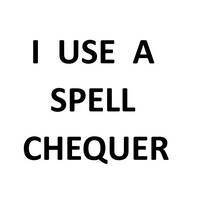 Not Yet Replaced By AI
Not Yet Replaced By AIThis transcription item is now locked to you for editing. To release the lock either Save your changes or Cancel.
This lock will be automatically released after 60 minutes of inactivity.